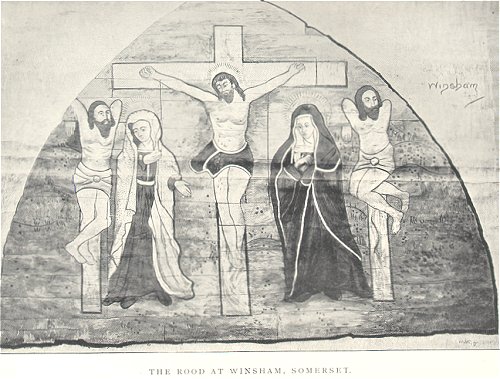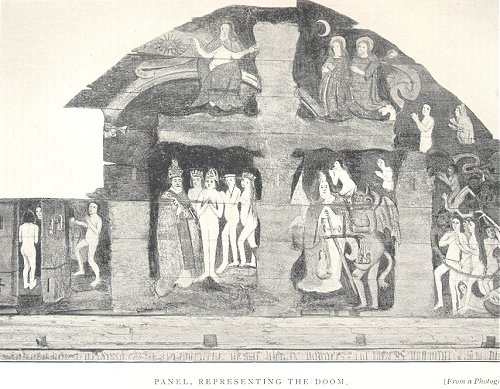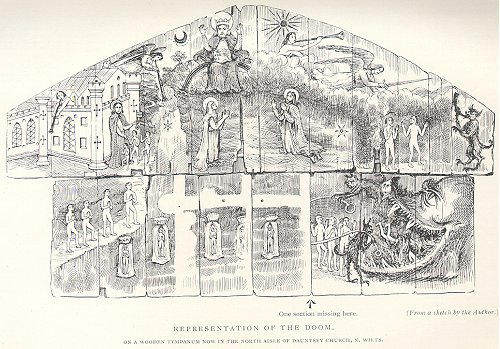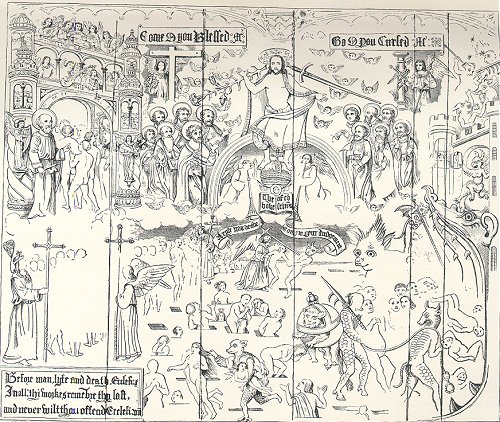|
by F.Bligh Bond, F.R.I.B.A (1903)
The original position of the panel was at one time a subject of speculation, but comparison with other works of similar character which have come to light leads to the conclusion that this was without doubt the partition or 'Tympanum' which formerly surmounted the Rood-screed and divided Nave from Sanctuary. Until the restoration of the church in 1876, there was a ringers' gallery under the tower, with a floor at or near the level of the head of the screen, forming an unsightly obstruction in the church. The painted panel was used as a back to this gallery, and being disguised by accumulated coats of whitewash, the Vicar had it removed with other obstructions. But upon evidence of the existence of painting coming to light, it was carefully preserved, and is now secured to the north wall of the church under the tower, the screen being removed to the eastward. The panel has attracted the notice of local antiquaries, and a drawing was made of it some years ago, which was reproduced in Volume xxxvii of these Proceedings. More recently a fine facsimile copy in colour has been executed for Mr. F. F. Fox, Past President of the Gloucestershire Archaeological Society, who has devoted a good deal of attention to the subject in his very valuable Presidential Address on Roods and Rood-Lofts (Vol. xxiiii of their Transactions); and a photographic copy was given, which, by Mr. Fox's courtesy, I have the privilege of reproducing here. Readers are referred to Mr. Fox's paper for the expert artist's opinion on the painting and its condition.
The Tympanum is the medieval substitute in the Western Church for the Veil of the Sanctuary, which the primitive church adopted from the Hebrew ritual. It has been shewn by Bingham and others that the tripartite division of the Temple was reproduced and perpetuated in the Christian Church, and it is known that it persisted in the west until a comparatively late date, whilst in the east it still forms an important adjunct to the ritual of the Armenian and Ethiopian churches. Durandus the monk, who wrote in the thirteenth century, has recorded that the use was maintained in his day, and he mentions that a veil or wall was the customary division, and this was prescribed in an Anglo-Saxon Pontifical from which he quotes. Elsewhere he alludes to a triple series of veils. St. Jerome is also recorded to have commanded the use of veils. The Anglo-Saxon Church always preserved very scrupulously an effective division between nave and sanctuary, and in some of our unspoilt early churches the solidity of the barrier is very marked, the chancel opening being extremely narrow. At St. Lawrence, Bradford-on-Avon, it is contracted to the dimensions of a mere doorway, whilst the height gives a vast flat space above, retaining traces of sculpture. The continuity of the idea is shewn in such examples as that at Sandridge, Herts, where there is a complete wall of separation, pierced with central doorway and side-lights. A similar, and probably later, example might have been seen at Cerne Abbas, Dorset, until the 'restoration', when it was opened up by the insertion of a chancel arch. It formerly presented the appearance of a solid wall over the screen to the roof. In other churches the chancel arch is subdivided, forming a sort of constructional screen, as at Stebbing, and Great Bardfield, in Essex. In later days, a screen of traceried wood or stone became of frequent, and lastly of universal, occurrence; and, coincidently, the necessity for a chancel arch of limited proportions disappeared. But though amplified in dimensions in later days, the chancel arch persisted as the most distinctive feature of the English Church, and it is often to be found built so low in comparison with the height of the nave, that a large space of wall remains above it. Such wall space seems to have been frequently utilised for the display of religious paintings. Where the rood-loft balcony was of sufficient height, as at Avebury, to mask the chancel arch altogether, all the balance of space over would naturally be available for fresco, and the wall would form a complete barrier; but it often happened that there would be a lofty archway, rising clear of the rood-loft, and this would be filled with a close boarded tympanum, which would not only render the division more perfect, but would furnish a more convenient means of support for the display of religious emblems or pictures, which would otherwise be relegated to too great a height in some churches, whilst in others there would be insufficient wall space to receive them. At St. Michael's Church, St. Albans, the painting was partly on the wall, and partly on a panel. Several examples of these tympanums survive, bearing ancient paintings. The Last Judgment is the subject usually represented, and it would appear that the Crucifixion, as represented at Winsham, is unusual. The west side of the screen was assigned to subjects of this character for the following reason. The screen was symbolic of Death, the barrier between time and eternity, between the church militant and the church triumphant. Thus the terrors of death to the impenitent, and the consolations of the last hour of the just, were aptly exemplified by a conspicuous rendering of the Doom in this position, and the Rood with its attendant images crowning the screen, conveyed the teaching of the divine conquest of death, and the intercessory powers of the saints. The "snares of death" were also represented by grotesque figures of dragons and other demoniac monsters carved on the western side of the screen, such as may still be seen at Sheringham, in Norfolk, on the spandrels of the beam of the rood-loft. On the east side of the tympanum the Resurrection was appropriately depicted, and nothing of a grotesque or evil nature is ever observed eastward of the screen. The Rood and attendant figures surmounting the screen were generally carved, and were occasionally attached to the painted panel behind them, as was the case at Wenhaston and Poslingford in Suffolk, and at Stratford-on-Avon, in the chapel of the Guild of the Holy Cross; whilst there are indications of a similar arrangement in the surviving instance at Dauntsey. Perhaps Winsham and St. Albans are the only instances which can be recorded of a painting of the Crucifixion upon the tympanum, and the latter has unfortunately perished, with the exception of the lower portion painted on panel - though a drawing is preserved in the library of the Society of Antiquaries of London. In this connection I may briefly mention that in the little mountain church of Llanelieu, Brecknock, there stands a double screen, supporting a boarded tympanum covered with a painted groundwork of plain dark colour, powdered with minute stars or flowers, whilst in the centre, above the rood beam, is a painted Rood, doubtless substituted for an earlier wooden one, the socket for which can be seen in the beam. An illustration of this is given in my paper on 'Devonshire Screens and Rood Lofts' in the Transactions of the Devon Association for 1902. A feature of note in it is the series of holes pierced in the boarding to enable the occupants of the loft to view the sanctuary.
The Wenhaston Tympanum, of which I give an illustration, is fortunately well preserved. It was discovered in 1892 under the whitewash of centuries, and is thought to have been painted about 1480, and covered up in 1549, in obedience to the edict of that date. Upon it the outline of the cross and figures formerly attached is clearly discernible. The whole of the intervening space is occupied by a representation in distemper colours of the Doom. In the upper part our Lord is shown seated on the rainbow, with kneeling figures of St. Mary and St. John Baptist. In the lower part we see the weighing of souls, in which St. Michael and Satan are taking part, whilst to the right St. Peter receives the souls of the righteous, and they pass into the Heavenly Mansions, and to the left the mouth of Hell receives the doomed. Of the others named in this category, those at Poslingford and Stratford have been destroyed. That at Poslingford was discovered in 1881 under a plaster partition filling the chancel arch. Drawings were made, however, and an illustration is given in the Journal of the Suffolk Institute of Archaeology, viii, 242. A drawing of the Stratford Doom is preserved in the library of the Shakespeare Memorial Association. For a knowledge of the remaining example, that at Dauntsey, N. Wilts, I am indebted to the Rev. F. H. Manley. I have been able to secure a sketch of it, which I here reproduce. The Doom is here depicted in the customary manner, but with some quaint and curious detail.
The representation of the dead in their shrouds is very curious. A similar feature is noted by Mr. Keyser in the panels of the St. Albans Doom. One of the lower sections of the Dauntsey panel is missing, where indicated by an arrow in the sketch. There are distinct marks of a framework having been at one time attached to the face, and I have no doubt this consisted of a Rood with the usual figures on either side. Another very fine panel painting of the Doom is preserved in Gloucester Cathedral. It was discovered about the year 1741, at the east end of the Nave, on the wall of the Roodscreen, close to the old clergy seats, where it had been carefully covered up. The painting is of post-Reformation date, and may probably be referred to the later years of Henry VIII's reign, or that of Edward VI. The figure of the Virgin is omitted, and the labels are in English.
The illustration here reproduced is taken from a paper communicated to the Society of Antiquaries in 1856 by Mr. George Scharf, F.S.A., entitled "Some observations on a picture in Gloucester Cathedral."Yet another interesting example survives at Mitcheldean Church, Gloucestershire, in its original position, filling the space over the chancel screen. Its date is said to be about 1480. It consists of eight panels, the Doom occupying the upper four, and subjects from our Lord's life, the lower series. This is described by Mr. C. E. Keyser, F.S.A., in his monograph on the Wenhaston Doom. He mentions one other such painting, brought to light when a portion of the plastering recently fell away, revealing figures of angels, no doubt forming part of a larger subject.
My notes on this subject cannot be considered complete without reference to the Post-Reformation variety of the chancel partition. So closely was the idea of the separation of nave and sanctuary interwoven with the conception of a church in the minds of the sixteenth-century clergy, that the Reformation, with all its storms and drastic innovations, failed to dislodge this feature of the older worship, just as it did not attempt the destruction of screens (choir screens). A reason for the retention of the Tympanum, and perhaps a cogent one, may also be found in the terms of the Order of 1604, which prescribed that the Commandments should be placed on the east wall of the church, and not, be it noted, in the chancel, for there they could not be seen by the congregation. Hence the Tympanum would furnish the desired support. Pictures of The Doom, though their removal does not appear to have been expressly ordered (the fact of the Gloucester picture being post-Reformation points in the contrary direction) would doubtless have been largely destroyed or obliterated when the roods and their attendant images were required to be removed; and no doubt many of the later paintings were of a debased and superstitious nature, but the idea of the Tympanum held strongly, and examples may be found dating from various periods after the Reformation. One may yet be seen in Somerset, of James I date, at Wyke Champflower, near Bruton. It has the Royal and Episcopal arms painted on the west side, while the east is covered with texts in Gothic lettering. There was a screen below, but this has disappeared. Another is still in situ at Parracombe, Devon. It retains the Royal Arms, commandments, creed, etc, all of Georgian date. Yet another finely painted figures of Moses and Aaron, was removed not many years ago from over the screen at Bridlestow, and is now in the possession of Mr. Simmonds, of Lydford, Devon. At Molland, the screen itself is late Georgian and above it is a plastered sympanum, supporting the usual tablets. The date 1808 appears on the panel containing the the Royal Arms, with the inscription "I.Mogridge, Churchwarden: Rowlands, Painter." The eighteenth century ushered in an era of increasing apathy in church which resulted in entire neglect of the fabric of our churches, while matters of symbolism and details of church arrangement seem to have been despised. Nevertheless, it was only in the nineteenth century, and with the growth of the evangelical movement, that the screens began to be viewed with positive dislike and suspicion, and there manifested itself a desire to sweep away all internal divisions, so that naught should remain to suggest or separation between the minister and his flock.
|


 In the centre is Our Lord exalted, sitting on the
rainbow whilst the angel sounds the trump. On the one hand are the
heavenly mansions, with the souls of the blest ascending (some in
their shrouds), and being received at the gate by Saint Peter, who holds
the key. On the other side the lost souls are being driven out by an
angel with a drawn sword, and the devil is seen prowling about for his
victims. Below is the conventional mouth of Hell, with extended jaws,
into which the condemned are being drawn by fiends.
In the centre is Our Lord exalted, sitting on the
rainbow whilst the angel sounds the trump. On the one hand are the
heavenly mansions, with the souls of the blest ascending (some in
their shrouds), and being received at the gate by Saint Peter, who holds
the key. On the other side the lost souls are being driven out by an
angel with a drawn sword, and the devil is seen prowling about for his
victims. Below is the conventional mouth of Hell, with extended jaws,
into which the condemned are being drawn by fiends.